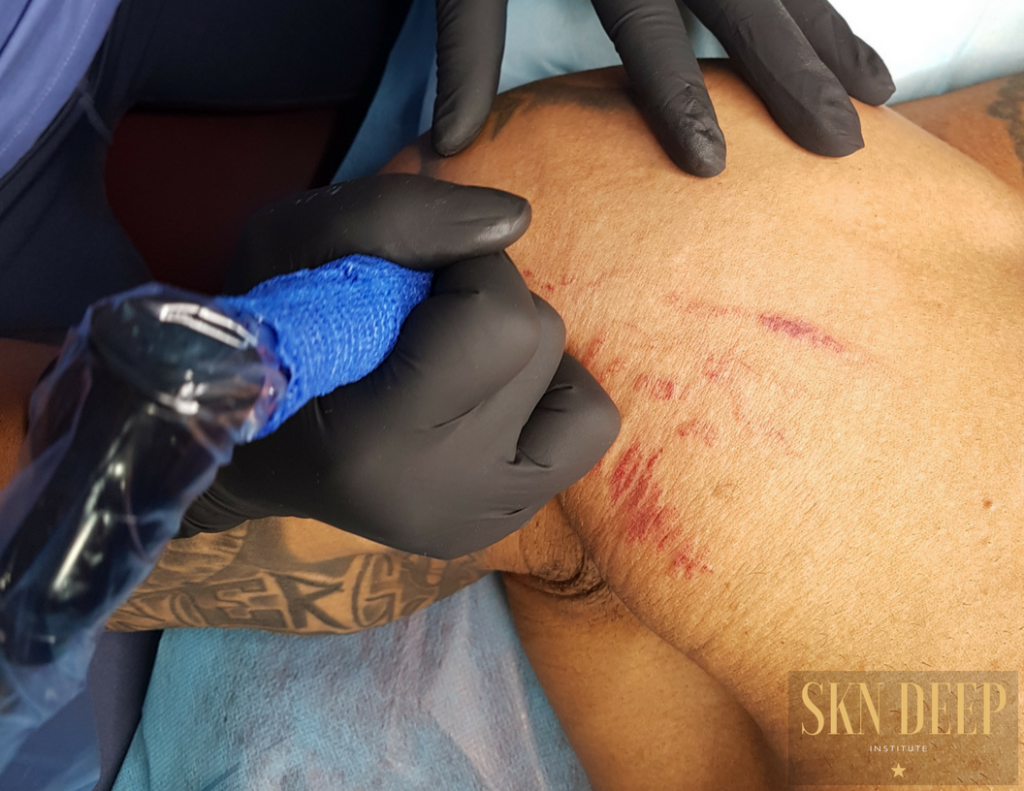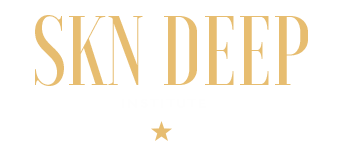Scar Revision Treatments
What is Dry Tattooing?
Dry Tattooing, MCA Microneedling, Dermal Needling, Inkless Camouflage & Micropuntura are all synonyms being used in the past 30+ years of a skin needling practice that was first documented in 1905 whose only common denominator is that no medium (serum, solution, glycerin, PRP or ink) is needed to glide the needles when creating micro-injuries on skin scars. This procedure triggers the skin’s natural healing process that can result in an improved appearance; digital or rotary tattooing equipment is preferred instead of microneedling pens. It’s not a new treatment and it doesn’t have a standard framework! Most trainers and practitioners use pointillism to stimulate the scar tissue, 1 machine setting and 1 to 3 needle configurations to treat every possible case; we work differently. At SKN Deep Institute we specialize in scar work. Thanks to our researches we created a precise methodology to achieve consistent results in less session without unnecessary trauma. First and foremost we do a scar analysis before each treatment to helps us determine which of the 4 tattoo machines that have been set up to treat different types of scarring are going to be used, we work with 11 different needle configurations and specific needling techniques that are chosen according to what needs to be corrected. The pre-care, care in studio and aftercare varies according to the customers’ Fitzpatrick scale and skin types. For these reasons we’re unable to give advice to people who had Dry Tattooing treatments done elsewhere and why we can’t guide practitioners we haven’t trained on how to achieve our results when we receive their consultations.
Why do we call it “Dry Tattooing” if we created a method?
Insurance companies and health departments around the world make a distinction between Dry Tattooing and Microneedling. Dry Tattooing can “usually” be performed under a body art license because no medium is being implanted in the skin. Regardless of the depth of the needling when using a medium it’s generally referred as Microneedling and according to the local regulations an esthetician license and in some instances a medical director may be required to provide service legally.
Because of the chosen equipment, needling techniques and care of the treated area the majority of the cases don’t need mediums to achieve dramatic improvements with our method, cutting in at least half the amount of sessions of what it’d take with professional microneedling or regular dry tattooing. At the studio in Bangkok we treat cosmetic and medical cases, sometimes working alongside doctors. In specific cases we use mediums to restructure specific scars faster and/or stimulate melanin production if hypopigmentation is presented to avoid using pigments in the area.
What is the treatment for?
The treatment has been developed by Paramedical Tattoo Artist Virginia Landolfi to target specific areas of damaged skin and scars forcing them to remodel their structure. It helps us to relax, fill and fade scars and improve skin’s density, texture, health and overall appearance. The micro-injuries we create in skin scars break down the damaged tissue and allow blood to come into the treated area bringing nutrients, oxygen and growth hormone that will result in the growth of healthy new tissue. We can treat surgical scars, burns, acne scars, stretch marks, wrinkles and skin rejuvenation on face and body.
How is this treatment different from microneedling?
In the market there are 2 famous tools for microneedling: dermarollers and pens. Dermarollers were created first by the plastic surgeon Dr. Des Fernandes who found out how the micro-injuries produced by tattooing equipment could induce the production of collagen and elastin. It was a tool designed to simplified the process and make it more accessible. Due to it’s shape it’s more appropriate for product absorption in cosmetic needling and nanoneedling. Microneedling pens as we know them today were developed later and became famous in the past 10+ years because they allow deeper needling in any area unlike rollers. The downside of microneedling pens are the need of “mediums” to glide the needles and their configurations that don’t allow scar isolation to properly stimulate the area taking longer to breakdown the scar tissue, they also affect areas that don’t need treatment causing unnecessary trauma and possible complications in the desired results. Another factor is unless pure saline solution is being used, the ingredients in serums and/or solutions can cause adverse reactions to the skin. With our system we avoid all these problems as no mediums are needed and we can isolate even the smallest scars. It’s the most precise form of skin scars needling treatment available in the market today with practitioners from around the world wanting to learn our method to provide the service in their area.
- Acne scars.
- Stretch marks.
- Surgical scars on face and body.
- Trauma or accident scars.
- Self-harm scars.
- Burns.
- Wrinkles and overall skin rejuvenation.
- Broken capillaries.
What scars cannot be treated?
Active Keloid Scars. They are raised and grow outside the boundary of the original scar tissue forming smooth, hard growths called keloids. Not all raised scars are keloid, hypertrophic scars are also raised but stay within the boundary of the original wound. Active keloids are still growing, inactive keloids have not grown for more than a year and the centre of the scar has become a more normal skin colour. Dry tattooing could be performed with caution and supervision throughout the healing period.
I’m taking Isotretinoin. Can I have Dry Tattooing done in my problematic areas?
If you’re on a low dose of up to 20mg per day and your doctor gives you the clearance, yes. A general consensus among international dermatologist was released a few years ago, in it’s publishing agrees that skin needling treatments can be provided during treatment as long as certain parameters are being met. Patients on high dose of Isotretionin (Accutane/Roaccutane) can have the first session 3 months after ending the treatment only if their dermatologist gives them a clearance.
- This ISN’T a scar removal service, however the look, feel and function of scarred tissue can be greatly improved.
- New tissue grows in the treated area.
- Loose and sunken scars and stretch marks begin to fill and firm up.
- Skin and scars discoloration can normalize.
- Raised and bumpy scars smooth and flatten.
- Tight, restrictive and fibrous scar tissue breaks up allowing more movement.
- Numb scarred tissue can begin to feel sensations.
Firstly we’ll have an online consultation where you’ll send close up pictures taken under natural light of the area/s you want to correct and provide the information requested to make sure it’s a case we can treat as there’re medical cases that need surgical revision, radiation and/or injections that we cannot treat. If your case can be improved with our methodology we’ll give you the option to schedule an in-person consultation or book your treatment.
Depending on your particular case you may receive pre-care instructions.
On your first visit the area to be treated will be assessed, pictures will be taken and you’ll have to fill in personal and medical forms. We cannot provide service to those who do not want to give the requested information that it’s vital for proper assessment and insurance protection.
In rare cases we use numbing cream, mostly when working on the face.
The equipment will be set in front of you so you can see where the disposable equipment comes from and how we take the appropriate measures to work safely. All cartridges come sterilised from factory in individual cases and are disposed right after treatment in a sharps disposal container.
During treatment you might feel a slight discomfort but since we work with tattooing equipment treatments are fast.
No pigment will be tattooed into your skin, the tattoo machine runs ‘dry’ unless for a medical reason a solution is needed.
Once the area is finished, it’ll be covered with micropore tape to protect it or similar.
- Suitable for all skin types and phototypes.
After treatment the area will look very red and some areas will have some swelling. Most people feel as if they had a sunburn on the treated area but it usually dissipates in 4o minutes post treatment. It doesn’t get sore for day as when you get a tattoo. It’s recommended to not exercise for the first 48 hours and to not take baths or swim for 7 days but you can shower right after treatment as long as you don’t remove the dressing. The treated area will start to flake off/peel from day 5 depending on your skin turnover. The redness will start fading as the days go by and your skin goes through the healing process.
How long before I see any results?
You will start seeing a difference from week 4, we usually compare cases on week 6 depending on what we’re treating.
How many treatments will I need and how long between?
It depends on many factors but for example in stretch marks and acne scars 3 treatments are recommended every 6 weeks. Six to eight weeks after the third treatment we reevaluate the case.
How long does the effect last?
For scars, burns and stretch marks results are permanent. New smoother skin will not revert, however the natural aging process will not be stopped. For wrinkles and thinned out skin, maintenance treatments should be considered.

I’ve done all the laser treatments available, not only are extremely expensive, I’ve got little results. I’m about to do the 4th session and I can see a huge improvement. I feel more outgoing and my friends and family are complimenting my skin!
Scars From
Stretch Marks
I was left with horrible thick scars from my breast augmentation surgery 3 years ago. Now not only are barely visible, the scar tissue feels like the rest of my skin.
